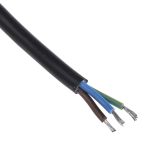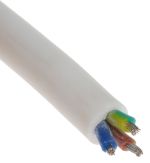Electrical Wiring Colours Explained
What do the different electrical wiring colours refer to? Find out more in our wiring colours guide.

Wiring Colour Codes
Changes to the wiring colour codes mean that fixed electrical and mains-powered cables (subsequent to the introduction of new cables) will feature the same colour wires as any flexible cabling. The blue wire, also referred to as the neutral wire, has the function of transferring electricity away from the appliance. The brown wire, otherwise known as the live wire, transfers electricity to the appliance. The combination of these wires is referred to as a circuit. You should be aware that some properties have old-style wiring, which should be regularly checked by an electrician to ensure that it remains in good working order. The need for replacement will be entirely dependent on the safety of the wiring.
The green and yellow wire is also referred to as the earth wire and has a key safety function. Electricity being transferred around any property will always take the path of least resistance to the earth. Damage to live or neutral wires could increase the risk of electrocution as the electricity may pass through the human body along its path to the earth. However, this is prevented by the green and yellow earth wire as it effectively earths the electrical appliance.
There should be some warning signage indicating installations featuring circuits and/or fixed cables and wires of mixed colours. This warning should be very clearly designated on either the fuse board or the consumer unit.
Wiring Colours
The electrician should attach appropriately-coloured sleeving to the different wires to enable easy identification of the corresponding wiring. As previously mentioned, the old-style black neutral wiring has been replaced with blue. Similarly, red live wiring is now brown.
There are varieties of cablewith similar colouring to the mains wiring. As an example, TV aerial cables don’t carry any voltage but do have the same brown colour as the live mains cabling. It is also common to find black cabling trailing behind the TV. This is the same colour as the old neutral wire. However, if there is any doubt, you should arrange for a professional electrician to carry out an inspection to ensure safety.
It’s also important to be aware of the difference between single and three-phase wiring. The single-phase connection is formed of two wires, with the three-phase variety being formed of three or four wires. The single-phase connection allows for the relatively easy balancing of electrical loads via the network. The three-phase connection is better suited to connection within workplaces featuring a variety of electrical machines and equipment, due to the increased generation of power. You can identify either the two or three-phase connection by counting the wires connected with the electrical service panel.
A single-phase connection will feature dual black or red live wiring and blue neutral wiring. There is a voltage difference of 230V between the wires. Either three or four wires will be connected to an electrical service panel functioning via the three-phase system. This will feature three live wires of either a black, red, brown or grey colour and a separate blue wire. There will typically be a 400V separation between the two live wires. It is important that you don’t make the mistake of confusing the natural blue and green/yellow earth connection when referring to the electrical system.
Brown = Live
As previously mentioned, the brown wire has the function of carrying electricity to the appliance. There will be a risk of electrocution if the brown wire is live and not connected to the earth or neutral wires. You must ensure that there is no power source connected with the live wire before working on the wiring.

Blue = Neutral
The neutral wire colour is blue. The neutral wire transfers electricity away from the appliance to avoid overloading. It is located at the end of the circuit for connection after the electricity has flowed around the live and earth wires. It is highly unlikely that you will have an electric shock on contact with a blue wire. However, caution should be taken as the wire can run at a very high heat.

Green and Yellow = Earth
The earth wire colour now features green and yellow stripes. It has the key safety function of connecting the metal casing of the electrical appliance with the ground. This means that the current of the live wire cannot be directly transmitted to the casing. Contact with the protective earth wiring should not result in an electric shock but exercising caution is always recommended.


More Useful Guides
Cat6 Cable Guide
Discover all you need to know about Cat6 cable in our comprehensive guide, designed to help you determine the best product for your needs.
Cable Clips Guide
Explore the main uses and types of cable clips in our complete guide before deciding which is best suited to your requirements.
Cat7 Cable
What are the features and applications of Cat7 cable? Learn how it builds on the preceding Cat5 and Cat6 Ethernet standards in our guide.
Cable Ties Guide
Which is the best cable tie to use? How should you undo cable ties? Find the answers to these questions and more in our handy guide.